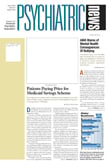Several years ago, moviegoers may recall, something quite extraordinary occurred in a gracious brown mansion in Philadelphia. A young boy attending a birthday party in the mansion had a paranormal experience that terrified him.
Yes, this was a scene from the movie “The Sixth Sense,” and the mansion where the scene was shot still stands on the corner of 22nd and Green streets in Philadelphia.
Thus, it is probably appropriate that only a few blocks away from this mansion some psychoanalysts got together recently to discuss ESP. They were attending the annual meeting of the American Psychoanalytic Association, which was held in Philadelphia’s Wyndham Plaza Hotel in May.
The discussion group, titled “Intuition, Unconscious Communication, and Thought Transference,” got off to an awkward start. Some 30 psychoanalysts trooped into a large room in the hotel that had been designated for the group and sat down at the long banquet table in the room. One participant quipped that if they were going to be able to communicate with each other under such unwieldy circumstances, they were certainly going to need ESP! However, the chair of the discussion group, Elizabeth Mayer, Ph.D., a psychoanalyst from Berkeley, Calif., circumvented that need and had the participants group themselves at only one end of the banquet table.
“There may be some of us in this room who do not believe that such things as ESP can happen,” Mayer challenged her colleagues. But a number of experiments support it, she pointed out. For instance, one researcher arranged for some 1,000 subjects to be called at unexpected times over several weeks either by friends or by strangers. The subjects guessed significantly more often when friends rather than strangers were calling them, suggesting that some form of ESP was occurring between them and their friends. Another investigator found that nursing mothers experienced let-down reflexes at the times when their infants, several miles away, experienced accidents or other mishaps. In another study, youngsters guessed significantly more often when they were being stared at than when they were not.
Also, Mayer continued, “I have found that many scientifically trained people have had an experience along the lines of ESP that they cannot explain. And I have, too.”
Some of her experiences, she said, have occurred with patients. For instance, a patient once told Mayer that she had dreamed that Mayer was going to Arizona. “That is amazing!” Mayer said. “I am going to Arizona. How did you know?” The patient replied, “I have dreams like this a lot, and they terrify me.” Mayer said that as far as she knew, she had given the patient no clues that she was planning to go to Arizona.
Another psychoanalyst reported that he too had what seemed to be an ESP experience with a patient. One evening, following a session with a depressed patient, he dreamed that someone committed suicide. The patient’s roommate called him shortly after to tell him that the patient had tried to kill herself. The patient’s diary later revealed that she had been planning to commit suicide when she visited him, but as far as he could tell, she had not given him any indication of it.
Yet if ESP can truly occur between two people, and especially between analyst and patient, how might it occur? “We need a scientific explanation for how this happens,” asserted Sydney Pulver, M.D., a Philadelphia psychoanalyst. “But I do not know where we are going to find it.”
When monks meditate, the parietal lobes in their brains are especially active, Mayer pointed out. So perhaps the parietal lobes are involved in ESP, she speculated.
In fact, Mayer suggested, perhaps analysts can cultivate a state of mind that allows ESP-type communication between analyst and patient, and that such cultivation might consist of meditating a few minutes before seeing a patient. “After all,” Mayer asked, “isn’t the analytic mind a quiet state of mind?”
To which another analyst replied: “Yes, and in the process we get closer to the patient.”
Mayer also suggested that analysts start collecting anecdotal evidence about their ESP experiences with patients. “I think it would be good for our field if people well established in it pulled such data together,” she asserted.
Another analyst took issue with this idea, however. “That clarity of consciousness that occurs on a good day between analyst and patient is certainly of interest. But if we really take this up as a cause célèbre, it is going to hurt our reputations as analysts since analysts have a fringe reputation already.”
To which Mayer replied: “I disagree. I think we could have a dialogue with physicists about it.”
“I don’t think modern physics can explain ESP,” Pulver commented. ▪
